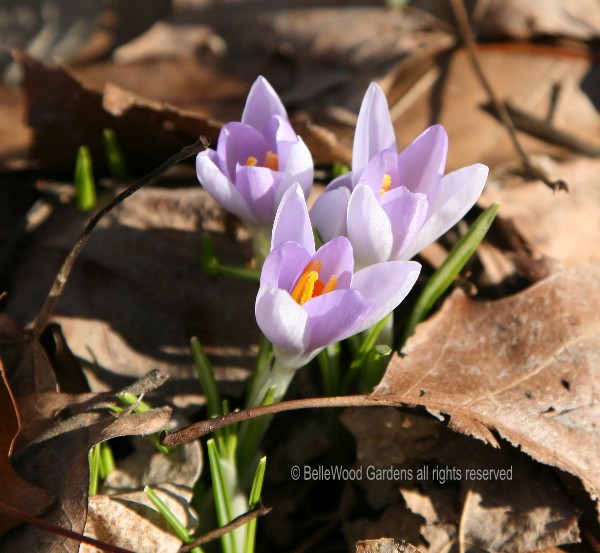| March | April | May | June |
| August | September | October | |
| November |
Saturday, 26 November 2011

Foliage embellishes the autumn / winter garden. As for example, the attractive leaves of Cyclamen coum.
It will hold both foliage and flower buds until early Spring, then take a summer break. Happy to also see
seedling leaves. Won't touch them now, shall wait until mid-spring and then move them out to a fresh site.

No, I didn't mis-type the month. It is November and there are snowdrops in bloom here in BelleWood
Gardens. This is Galanthus 'Potter's Prelude', a lovely snowdrop of good substance that flowers for Thanksgiving.
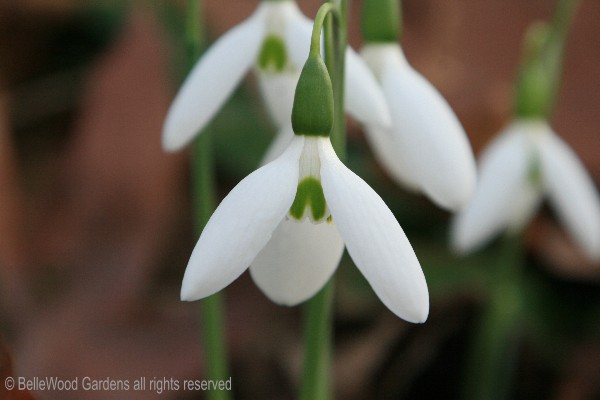
Saturday, 22 October 2011
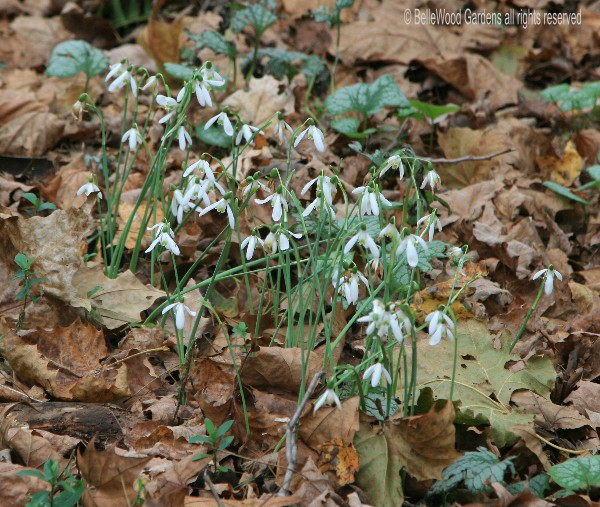
The rains have abated and a few lovely autumn days have graced us with their presence. I went down
into my woods and was, once again, pleasantly astonished by snowdrops at the other end of the year.
Label vanished, I asked John Grimshaw, Brittish galanthophile and expert on the genus who it might be.
His reply, "That's Galanthus reginae-olgae - as fine a patch of it as I've seen outside Greece."
Welcome, and puzzling. I know I used to have Queen Olga's snowdrop. It used to be a very crowded patch
over by the steps into the garden. And every autumn when the colony of snowdrops came into bloom I would think,
"That congested clump really needs to be lifted and separated." Apparently I did follow through on that thought!
I mentioned this to John, who said,"Queen Olga certainly looks good, but perhaps put a few somewhere else
as well - large clumps are notoriously apt to disappear. Preferably move them as they go dormant." I shall
make a note in next year's calendar, along about next March. Nothing like getting an early start creating a to-do list.

.

Chrysanthemums seem more typical of the season. 'Sheffield Pink' is one of my favorites.

I'm very fond of - choose one - helmet flower, friar's cap, soldier's cap,
monk's hood, or wolfbane. Late blooming and lovely. Aconitum napellus

.
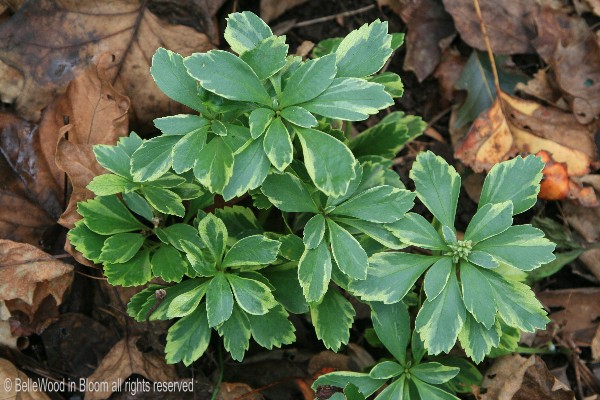
Pachysandra is that boring green groundcover apparently rolled out by the yard, like carpeting.
Unless, that is, you seek out options, like this attractive white edged Pachysandra terminalis 'Variegata'.

Another excellent foliage perennial for the autumn and winter garden is Arum italicum 'Pictum'.
Summer dormant, it sends silver-veined leaves up in fall that remaining evergreen all winter.
Good for cut arrangements too.Jack-in-the-pulpit type flowers in spring, ducks back underground
for summer, then sends up stems of vivid orange-red berries before the leaves appear in fall.
Sunday, 11 September 2011

Oxblood lily, schoolhouse lily, call it what you will this charming little
autumn-flowering bulb, Rhodophiala bifida is a hippeastrum relative
from South America. Happily at home in places like Giddings, Texas.

Also summer dormant Cyclamen hederifolium presents its first flowers in late August
soon afterwards followed by winter-green leaves. The fancy term for this is precocious.
Thursday, 29 September 2011

This Japanese woodlander, Salvia koyame reveals its spikes of pale yellow
snapdragon-ish flowers in late September, untouched by Bambi and his brethren.

Sunday, 11 September 2011

Oxblood lily, schoolhouse lily, call it what you will this charming little
autumn-flowering bulb, Rhodophiala bifida is a hippeastrum relative
from South America. Happily at home in places like Giddings, Texas.

Also summer dormant Cyclamen hederifolium presents its first flowers in late August
soon afterwards followed by winter-green leaves. The fancy term for this is precocious.
Sunday, 28 August 2011
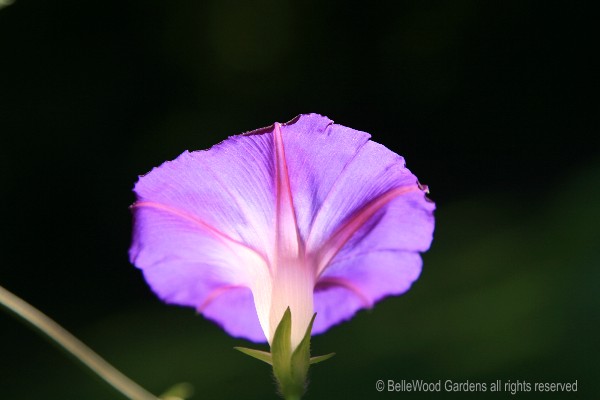
Grandpa Ott's morning glory, illuminated like a stained glass window

Night-blooming flowers of Moonflower vine, Ipomoea alba open at
day's end, its greenish buds jerckily unfolding as you watch.

Another climber, this one holding on with little aerial rootlets.
Begonia convolvulaceae is not attractive for flowers,
(small sprays of white blossoms in late winter) but fabulous
glossy green leaves rapidly covering trellis and climbing the wall.
Tuesday, 14 June 2011
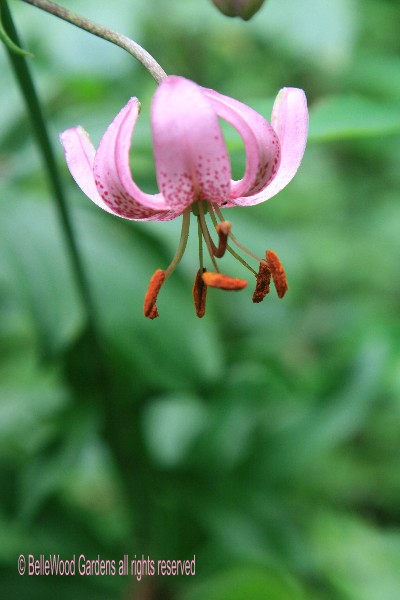
Tall growing, Lilium martagon carries multiple small Turk's cap flowers
with thick, substantial petals. There's also a white form, and a darker one too.

Digitalis lutea is more reliably perennial than the perhaps more familiar
rosy pink foxglove. As you can see, it seeds itself about and has made a nice colony.

Deer leave the pale yellow flowers, faintly freckled inside, alone.

"Knotweed" is a plant to strike fear in a gardener's heart. Japanese bamboo likes highways here in
New Jersey. Chop it up and the pieces root. Supposedly this pretty variegated form is better behaved.
I'm taking no chances. My Fallopia japonica 'Variegata" is kept confined, grown in a large container.

The foliage is quite attractive, as white splashed leaves mature from the distincly pink spring shoots.
Friday, 10 June 2011
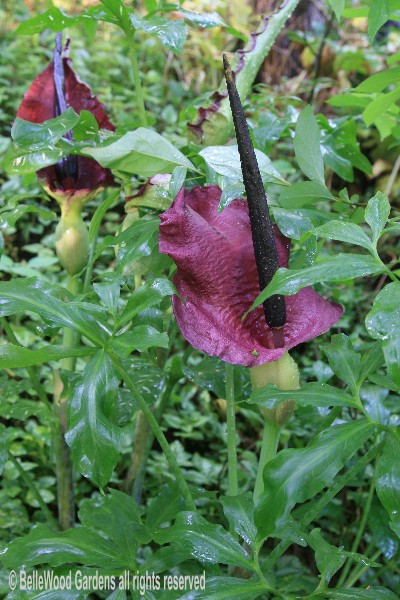
Dragon arum, Dracunculus vulgaris, another one of those stinky aroids pollinated by flies.
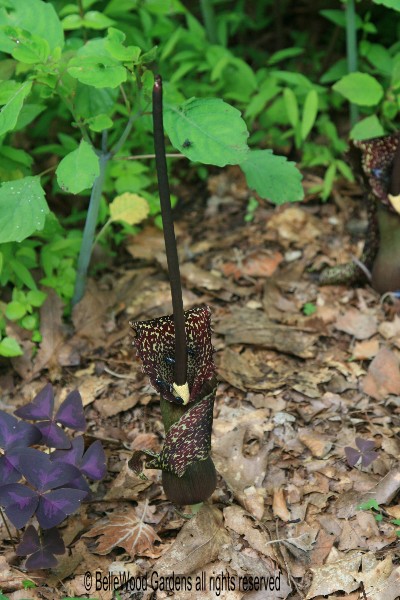
As is red calla, Sauromatum venosum. This one needs dug and stored indoors over winter.
Tuesday, 31 May 2011

Most of the pinellia are absolute thugs when it comes to multiplying. Pinellia cordata is somewhat
better behaved. Prettier, too. In Japan it is grown in a pot. Easier, said my friend Nihei-san, to lift
up and that way enjoy the delicate fragrance of its Jack-in-the-pulpit-like small green flowers.

I move my multiple pots of Hippeastrum outdoors for the summer. Silly bulbs often start to bloom.
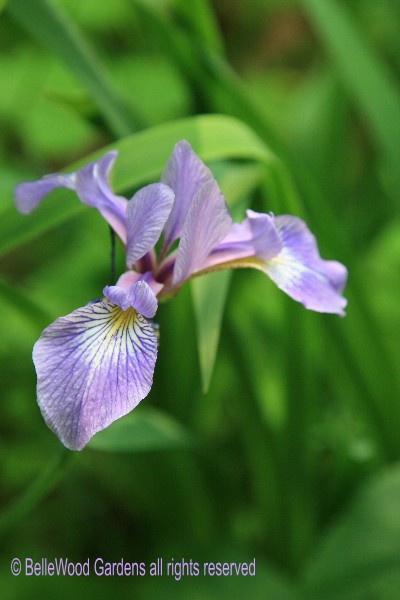
Iris versicolor is a native beardless iris that likes to grow near water.
A pretty thing, with delicate markings on the falls, accenting the bee guide.
Thursday, 19 May 2011
It has been raining so much - that's both frequency and duration - that I haven't had much chance
to dart outside and take pictures. Good pictures that is. And I won't show you bad ones. Enjoy these.

Sapphire berry, Symplococos paniculata, is a wonderful small tree. At this time of year it covers itself
with a frothy lace of small white flowers. In autumn, the berries are, well, sapphire blue and quite attractive.

.

Viburnum plicatum 'Mariesii' has flowers layered out on each branch.

Diphylleia cymosa nearly finished flowering before the rain let up
enough for me to skip outside and get some images. Great foliage too.

.

Hosta 'Krossa Regal' has a lovely vase-like form and elegant gray-green leaves with incised veins.
Attractive partner for large ferns, big astilbes, and either Rodgersia pinnata or R. aesculifolia.
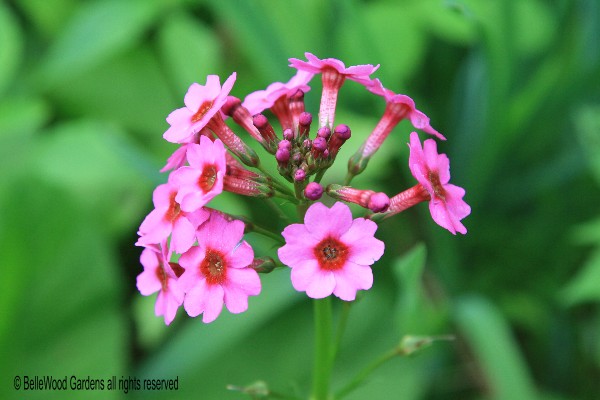
Primula japonica is one of the candelabra type - tall stem with several ascending whorls of flowers.
Tuesday, 3 May 2011

Umbrella plant, also known as Indian rhubarb, Darmera peltata,
is a great plant for sunny sites with soggy soil. Precocious flowers,
dainty white petals around a pink center appear before the leaves.
Peltate (rounded, with the stem near the center) and up to 12 inches
across emerge soon afterward. Thickened rootstock spread to form
enlarging colonies. Easy to separate a piece to plant elsewhere.
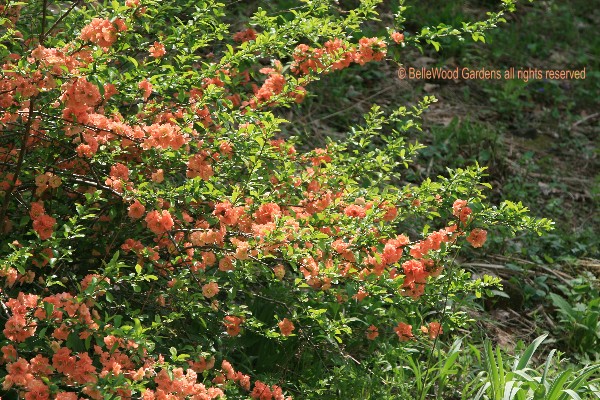
Chaenomeles 'Cameo' has delicious apricot-orange flowers
much softer than the often seen brick red which I have difficulty
in finding suitable partners. Much easier to work with 'Cameo'.

Thursday, 28 April 2011
A hiatus in the rain meant a walk around the garden to see what's about to bloom / in flower / gone by.

Arisaema thunbergii now in full flower from almost there on 24 April.

Primula kisoana, pretty in a rather vivid shade of pink, along with redbud, Cercis, and some daffodils.

.

Trillium grandiflorum, beaded with raindrops.
And the ruffled, flounced beauty of its double form
Trillium grandiflorum 'Flore pleno'.

.
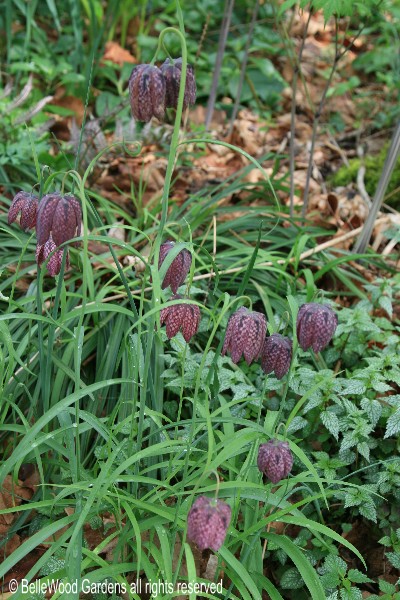
A nice little colony of Guinea hen flower, Fritillaria meleagris.
Also known as snakes head, checkered lily, and leper's bell.
It seems remarkable that so slender a stem can support so
large a checkered bell. A welcome, deer resistant flower.

Paeonia japonica is a peony that's early into flower, and also one that likes to grow in woodland shade.
Tuesday, 26 April 2011

Brunnera 'Jack Frost' is welcome in woodland gardens for its bold silver leaves veined with green.
Embellished, mid-Spring, with clusters of - same color, similar appearance - forget-me-not flowers.

Vinca minor, running myrtle, is one of the "big three" of evergreen
ground covers. It comes with variations - white edged leaves or
flowers of another color, such as this rich 'Burgundy' cultivar.

As I've already declaimed, several times, lesser celandine, Ranunculus ficaria, is a thug. Just to add
to the confusion here's the greater celandine, Chelidonium majus. Naturalized in the eastern United States
it does self-sow. Though also considered an invasive plant I find it easier to remove than its little namesake.
 . Tulipa 'Little Princess' .
. Tulipa 'Little Princess' . 
There's something charming about miniature versions of typically larger plants. The May flowering Darwin Triumph tulips easily reach 24 to
30 inches tall with large and stately flowers. Then there are these dainty charmers: above is Tulipa 'Little Princess', just 6 inches tall.
A cross of two species - Tulipa hageri and T. aucheriana, outside, the petals are washed with warm and sunny orange and inside,
blotched with black and rimmed with a ribbon of yellow. A handful, just six of these little bulbs make a fine display. And then
there's Tulipa hageri 'Little Beauty', rose pink exterior that opens wide in sunlight to a slate blue center rimmed with white. Wonderful!
 . Tulipa 'Little Beauty' .
. Tulipa 'Little Beauty' . 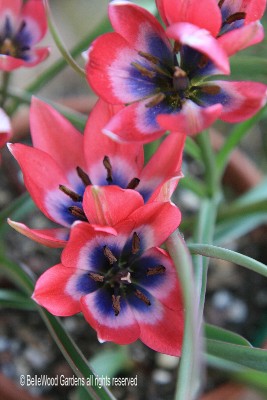
Sunday, 24 April 2011
This year the weather has been fairly consistent, somewhat cool, and rather wet. Last year, most of what is currently in flower in late April was in bloom 14 days or more earlier. On time, (whatever that means) early or late, these plants are always welcome in BelleWood Gardens.

Asarum caulescens is a deciduous Japanese ginger with charming dark green, deeply veined leaves.

.

So many plants from Japan thrive in my woodland garden. This cloak-like
leaf will expand from its broken umbrella form to a jagged edged palmate
shape. Call it shredded umbrella plant, or Syneilesis palmata. Funky.

Looking somewhat like a fishing line (and yes, there's a story attached
to that) is the long whip-like extension on the spadix inside the not quite
open spathe of Arisaema thunbergii var. urashima, Japanese relative
of our native Jack in the pulpit, A. triphyllum. Good deer resistant plants.

Hylomecon japonicum scatters sunshine in the shade, nice sized golden flowers against dark green leaves.

And the last of today's Japanese plants happily growing abroad in my
garden is Primula kisoana with hairy leaves and vivid fuchsia flowers.
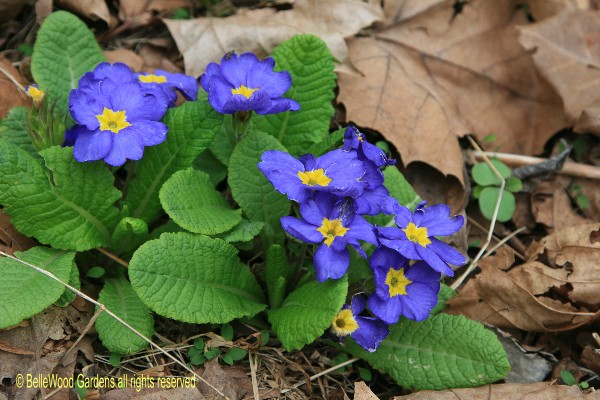
Primroses and Spring. That's the title of Doretta Klaber's book. And welcome are primroses in the
Springtime garden, such as these yellow eyed, pin flowered, blue blossoms on Primula polyanthus.

Today's overcast skies are excellent for photographing blue flowers, such as these Anemone blanda.
Their white-eyed, daisy like flowers arise from small tubers, shipped dry and dormant in autumn. It helps
if the tubers are soaked overnight in damp peat moss before planting. Charming at the edge of woodland.
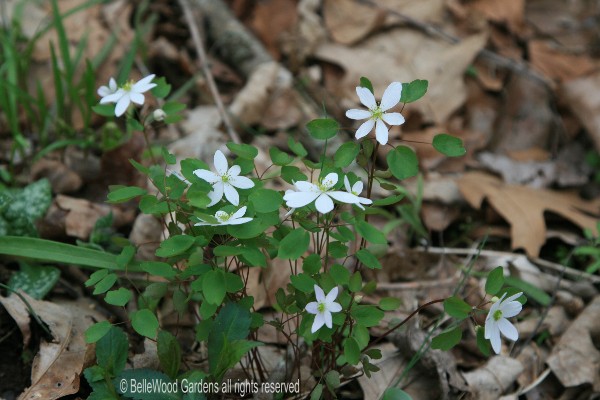
Dainty native, Anemonella thalictroides is happiest undisturbed. I leave it to grow where it will.

Cannot say the same for Virginia bluebells, Mertensia virginica. It will insist on seeding about.
That's fine in the planting area, more of a contentious issue when it does so in the path.
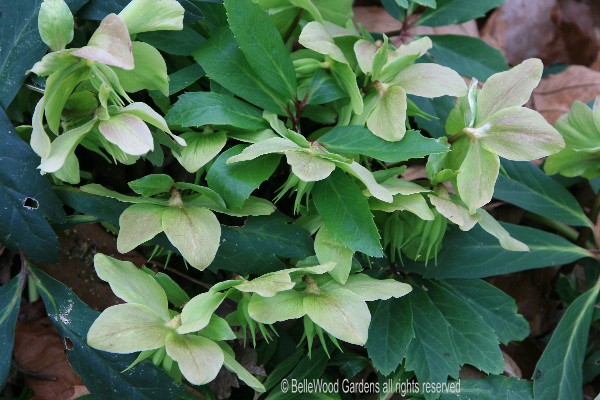
Christmas rose, Helleborus niger, is moving on from flowering to seed production. After all, that IS
the whole purpose of advertising for pollinators. Looks like it will be a good crop of seeds this year.

Tightly packed with petals, this double flowered ranunculus is well behaved, not aggressively spreading.

Black leaved 'Brazen Hussy' is somewhat more enthusiastic, but not to the point of being a bother.

I don't think of April as summer, yet that's what aestivum means.
Oh well. Meet the summer snowflake, Leucojum aestivum.

There's something about the poeticus daffodils. The wild species stamps its progeny alike with small
ruffle of a cup banded red / yellow / green, and pure white petals. Superb, especially on foggy mornings.
Thursday, 21 April 2011

The crown imperials, Fritillaria imperialis, are magnificently in flower.

I have four colonies, planted a number of years ago with - was it 3 or was it 5 - bulbs to a group.
Whatever. It is clear that they've been multiplying. This is somewhat peculiar because these big bulbs
are difficult to satisfy. And this site with its clay-ey soil partway down a slope where it can be wet
should most definately not be what they like. This group currently has 9 stems in bloom, each with
six or more of the large orange flowers. There's another about to color up, and several without buds.

So stately a plant demands a similarly sized companion. The best, I've found, is Spirea 'Gold Flame'.
Friday, 15 April 2011
A somewhat overcast morning with thin high haze. A good day for photography, so before I get down and dirty in the garden I went on a photo shoot. Some very nice results, as you can see.
 . . .
. . . . . .
. . .
Above left, 'Carnegie' . . . . . . . . . . center, 'Yellow Queen' . . . . . . . . . right, Gipsy Queen
First are the hyacinths. So sweetly fragrant. Just one stem in a small vase is adding its pleasing aroma to my study. I wish there were a way to add their perfume to this BelleWood Gardens entry. Hyacinths come in so many colors that I believe that Iris, goddess of the rainbow, must have touched them with her magic.
Below . . . . .'Splendid Cornelia' . . . . . . . . . . . . . . . . .'Blue Jacket'
 . . . .
. . . .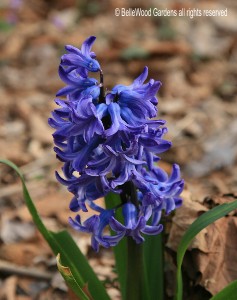
.
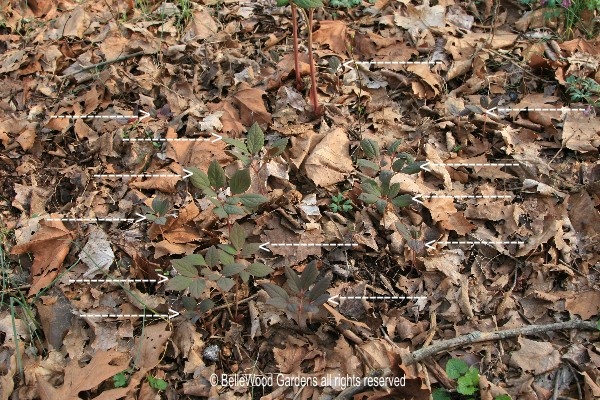
As well as flowers it's a time of year for seedlings. The stinkin' weeds are at it of course, and as well are some highly desirable perennials. Such as, for example, Paeonia obovata 'Alba'. The white arrows in the above image point to the dozen or so infant plants. Patience is required for raising peonies from seed. Each pea-like metallic blue seed is best sown fresh, in autumn. Don't expect to see anything next Spring. First germination takes place underground, as a radicle, or root. The smallest of these seedlings is thus already two years old when they send up leaves into the light of day. I simply push the seed into the ground around the parent plant and let them germinate when and as they will. After all, after a couple of years each Spring sees more seedlings making an appearance.

Same circumstances hold true for trillium. First, germination of a radicle
and then the second Spring a single little spade-like mottled leaf appears.
Trillium are a little more complicated than peonies because ants collect
the seeds and carry them away. Myrmecochory this is named. Whatever.
One of my favorite sessile trillium, Trillium cuneatum. Easy, early, nice.
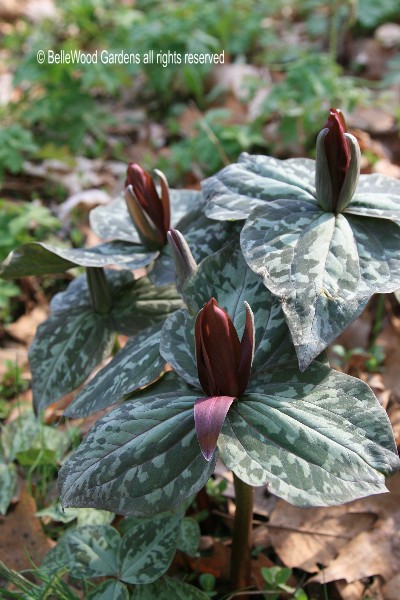
.

Lungwort its common name, much the same in Latin, Pulmonaria Pink buds open into blue flowers.
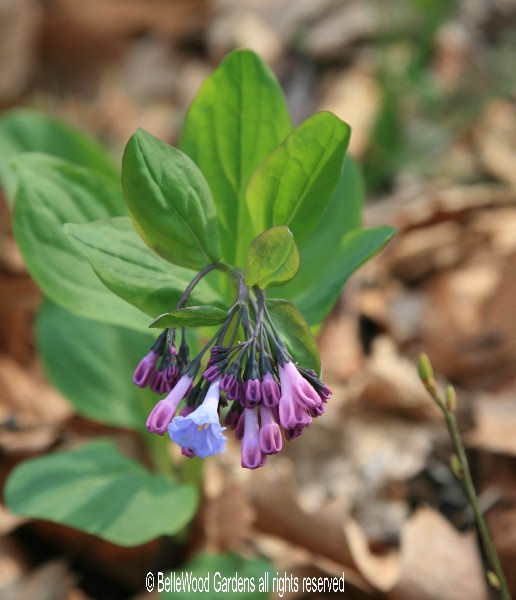
The same color progression is true of Virginia bluebells, Mertensia virginica.

The first plump, chunky bells of Guinea hen flower, Fritillaria meleagris, are beginning to appear.

Christmas rose (what a daft common name! It doesn't flower in December and has nothing to do with
roses.) I have them in a location that seems to suit quite well, as self-sown seedlings generously appear.
Left alone for a couple of years, they get some size and I'm more comfortable transplanting them.

No such luck here. Helleborus ×ericsmithii 'HGS Silvermoon' which one nursery site describes:
"Creamy white blossoms are tinged pink and mature to a dusky rose. Upright growth with silver
leaves on rosy stems. Ideal for shady beds, borders and containers." It's thriving. I'm content.
Saturday, 9 April 2011

Fritillaria imperialis. On March 15 they were just emerging above ground.
Three and a half weeks later there's massive foliage but not, as yet, any flowers.
Friday, 8 April 2011

Helleborus niger and the only thing niger (= black) about it are its roots. Certainly not its flowers.

Trillium cuneatum is one of my favorite trilliums: early, easy, attractive foliage, and charming flowers.
These are not yet open. But how nice the mottled leaves on this vigorous little colony.

Glory of the snow, Chionodoxa forbesii, shows off its sky-blue flowers,
accented with a large white eye. Another easy little bulb for the shady garden.
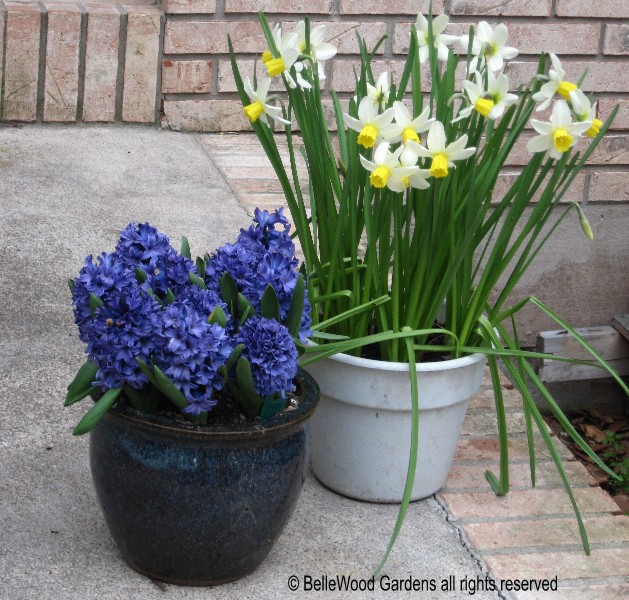
Bulbs in containers at the doorway welcome visitors with attractive flowers and hyacinths' delicious perfume.
Sunday, 3 April 2011

A closeup of satiny, green-gold flowers and ferny foliage of Adonis amurensis.

Scilla bifolia, two leaves, one sided raceme of starry, true blue flowers.
Saturday, 26 March 2011
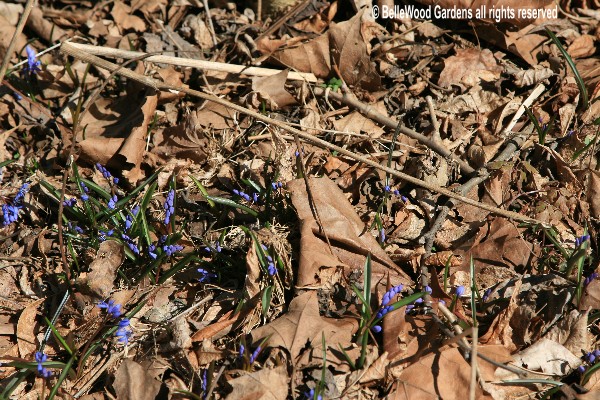
Scilla bifolia, flowers tightly folded in bud, soon to open.
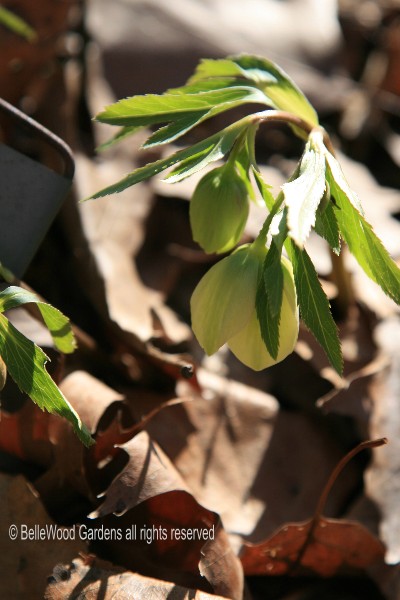
Aptly named apple green flowers of Helleborus viride

I love all hellebores, but am especially fond of the deep plum flowers of Helleborus Early Purple Group.
Tuesday, 22 March 2011
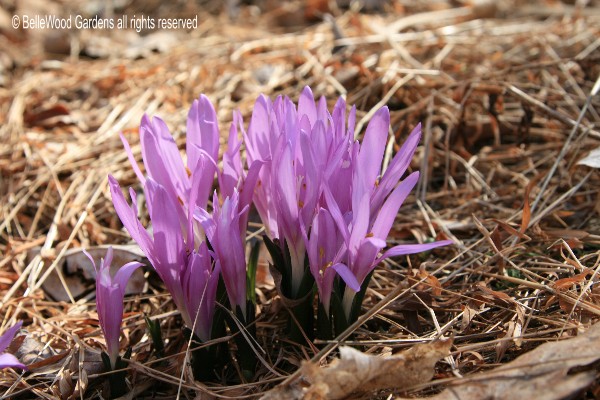
Colchicum (=Bulbocodium) vernum. I probably should dig and divide . . . . add to the "to do" list.
Monday, 21 March 2011

The calendar may say Spring but winter is reluctant to depart.
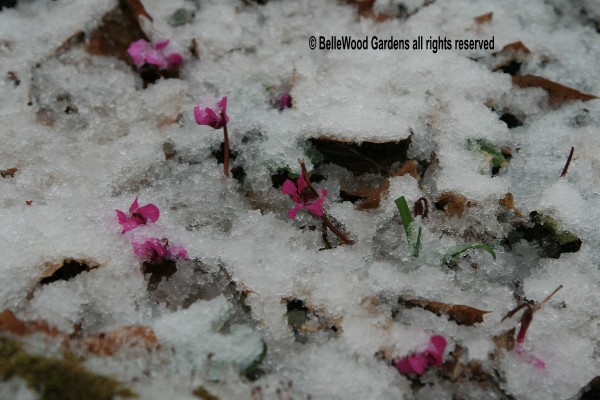
Cyclamen coum appears incandescent, fluorescent pink against a layer of icy snow.

Eponymous name, snowdrops vanish against a thin blanket of snow.

Winter aconites, Eranthis hyemalis, petals cupped, protect their pollen, and - temporarily - appear rather dull.

As if some vegetative antifreeze was circulating Helleborus Early Purple Group are unfazed by icy snow and cold.
Tuesday, 15 March 2011
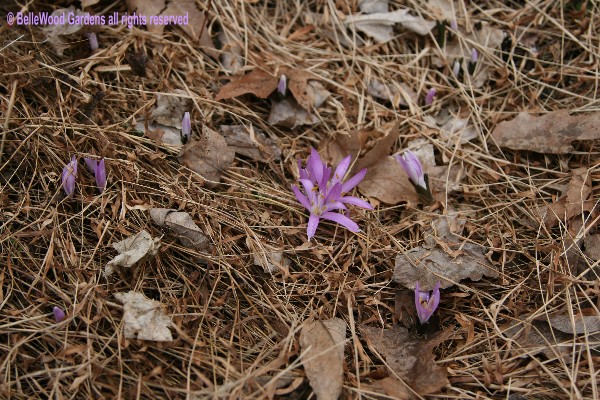
Colchicum ( =Bulbocodium) vernum

Colchicum ( =Bulbocodium) vernum closeup

Fritillaria imperialis beginning to emerge from its long sleep.
Friday, 11 March 2010

Snowdrops arising among a clump of Arum italicum, with a scattering of winter aconite

The golden flowers of Eranthis hyemalis, winter aconite, lend a sunny note to the most overcast days of Spring.

.

There's a charming little Japanese cousin. Eranthis pinnatifida has dainty, ghost-pale flowers crowned
with pollen-filled golden stamens. I'm told it transplants poorly, and the newly ripened seed must be sown
in situ if there's to be any chance of success. A friend in Japan was gracious enough to send me some.
I think of him each March when it flowers, and how grateful I am for his generosity. It spreads, but slowly.
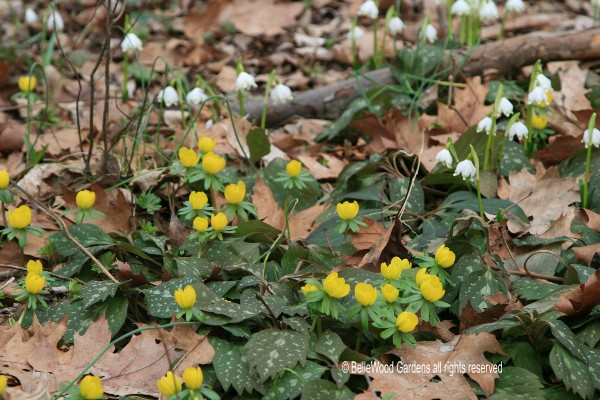
Its more vigorous "cousin" makes a fine partner for other little bulbs, such as Leucojum vernum, spring snowflake.
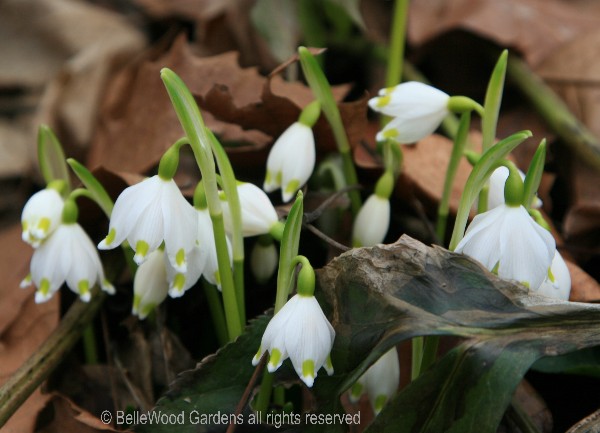
When viewed close up, the green-tipped little bells of Leucojum vernum may easily be distinguished from snowdrops.

For me, one of the best things about gardening is that it is truely the never-ending story. It seems that
there's always more to learn. When I first wrote the entry for this charming snowdrop I took a quick look
in the RHS Manual of Bulbs. The information there noted that instead of Galanthus woronowii I should
look up the description for Galanthus ikariae. has grass-green leaves. Some people say it is sparsely flowered.
In that case this must be an especially good clone as it has always bloomed quite freely here.
Tuesday, 1 March 2010

